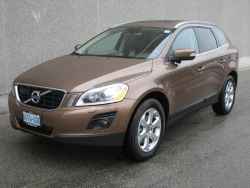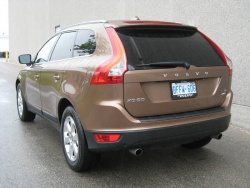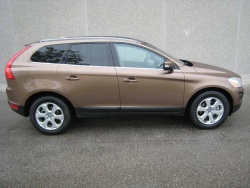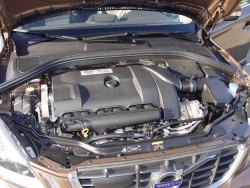 2010 Volvo XC60. Click image to enlarge |
|
Related articles on Autos
Manufacturer’s web site
|
Review and photos by Jil McIntosh
Find this vehicle in Autos’s Classified Ads
Photo Gallery:
2010 Volvo XC60
Oshawa, Ontario – Every year at the auto show, there’s always one concept model that catches my eye and won’t let go. In 2007, it was Volvo’s XC60 Concept, a lovely little vehicle that forever banished any memory of boxy models with its flowing lines and wraparound taillights. Unfettered by the realities of production, concepts can vary considerably by the time they get to the assembly line, but the XC60 has made it to the showrooms with most of the touches that appealed to me in the first place, and with a driving experience that lives up to the promise.
This is a genuinely nice car: comfortable and sweet to drive, with enough sporty characteristic to keep it interesting. It’s relatively practical, beautifully styled, and should you want them and are willing to open your wallet, it can be equipped with a gaggle of active safety features. Included in the price is Volvo’s newest technology, a City Safety feature that will bring it to a halt if you’re about to bump the vehicle in front of you.
 2010 Volvo XC60. Click image to enlarge |
All XC60 models currently available come in one configuration, with a turbocharged 3.0-litre six-cylinder T6 engine producing 281 horsepower, a six-speed automatic transmission with manual shift mode, and a Haldex all-wheel drive system that’s front-wheel biased under normal driving, but will transfer power to the rear if necessary. Pricing starts at $45,495, but that’s going to change in the future.
In June, Volvo announced that it will also equip the XC60 with a 235-horsepower, naturally-aspirated inline six-cylinder that’s also used in the S80, V70, XC70 and XC90. It’ll come in front-wheel drive, starting at $39,995, while a version with the all-wheel system with several other upgrades will be $44,495. My tester, the T6, will remain all-wheel only, but it will receive several new features and will rise to $49,995. While lower prices and more choice are always welcome, I suspect some of this may be due to the fact that the larger and very popular XC90 starts at $48,595: that’s just $3,100 more than the current base XC60, and that’s not a huge sum of money when you’re already up at this level. Options and upgraded trims can move most Volvo models into the stratosphere faster than the space shuttle, though: the price of my tester’s option list could have purchased a subcompact car. The XC60 will also add a new optional R-Design package, which upgrades the wheels and handling, among other features.
  2010 Volvo XC60 (bottom photo by Greg Wilson). Click image to enlarge |
Smaller than the XC90, less outdoorsy-looking than the XC70, the XC60 falls into the upscale small SUV/crossover market that’s populated by such manufacturers as Lexus, Acura, Audi, Volkswagen, BMW, Mercedes-Benz and Infiniti. Expect this niche to become wildly popular as North Americans fall out of their full-size SUVs but with an unwillingness to move into traditional cars.
The XC60 is based on a shortened version of the S80 sedan’s platform, which also makes it a cousin to the V70 and XC70, as well as the Land Rover LR2. Unlike the available-seven-passenger XC90, it’s strictly two rows of seats, for a maximum of five passengers.
The turbocharged six-cylinder is a very sweet engine. It makes 295 lb-ft of torque, and at a very low 1,500 r.p.m., making the XC60 very responsive to throttle pressure even as it delivers its power smoothly and quietly. The downside to the engine is that it isn’t terribly fuel-efficient: it’s rated only at 13.5 L/100 km in the city and 9.1 on the highway, and in combined driving I could only manage 12.4 L/100 km (23 mpg Imp). That’s certainly nothing to write home about, especially when several competitors can do much better in published city driving figures: 12.5 for the BMW X3, 12.5 for the Acura RDX, 13.3 for the Mercedes-Benz GLK, and 11.2 for the Volkswagen Tiguan. The upcoming non-turbo model will probably help somewhat; in the meantime, the T6’s thirst is partially offset by the fact that the recommended fuel is 87 octane.







 Follow Autos on Twitter
Follow Autos on Twitter



